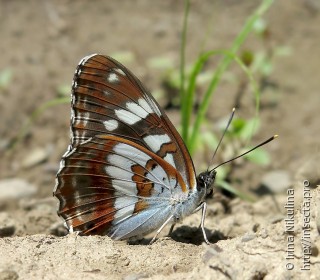Limenitis helmanni Lederer, 1853

Taxonomy
class Insecta → subclass Pterygota → infraclass Neoptera → superorder Holometabola → order Lepidoptera → superfamily Papilionoidea → family Nymphalidae → subfamily Limenitidinae → tribe Limenitidini → genus Limenitis → species Limenitis helmanni
Species name(s)
Limenitis helmanni Lederer, 1853.
urn:lsid:insecta.pro:taxonomy:16790
Expansion
This species marks on the maps: 3.
Zoogeographical regions
Palaearctic.
Russia regions
#23. Predaltaisky; #28. Zabaikalsky; #36. Sredne-Amursky; #37. Nizhne-Amursky; #40. Primorsky.
Flight time
| January | February | March | April | May | June | July | August | September | October | November | December |
Over-wintering stage
Ova.

Detailed information with references
Taxonomy, synonyms and combinations
Distribution
- Regions of the Russian Federation: the Trans-Baikal, the Lower Amur, Prealtay, Seaside, Mid-Amur. [3].
- Outside of Russia: Eastern. and South-Eastern. Kazakhstan, China, Korea, Japan
In the west, the area is found along the coastal bush honeysuckle, among the bushes on the hills and mountain slopes, forest meadows, relict in linden.
In the south of the Far East it is found everywhere in deciduous and mixed forests of mountain, in gorah- to the upper boundary of the forest. [2].
Imago Habitus and Differences from alike species
- Hindwings from below in basal and anal parts with a broad bluish-white field, not concave to the base along the posterior vein of the central cell. [130].
Imago lifespan
- One generation. In the west, the flight of the area in June and July, the Far Vostoke- from mid-June to early September. [2].
General info about Larva
- Last instar caterpillar is similar to camilla. It is bright green, lower body and abdominal legs - a whitish-green. On the dorsal side of the 2, 3, 5, 10 and 11th segments paired light green or reddish protuberances 2-3 mm in length, they are covered with spines. On the sides of abdominal segments whitish-green band.The head is whitish with a picture of 4 vertical red-brown stripes, covered with numerous spines, two of which-is necessary glazkami- longer and darker than the others.
Pupation usually on the bottom sheet of the central vein. [2].
Larva food plants / other food objects
- In Altai: Lonicera altaica Pall. (Altai Honeysuckle), Lonicera tatarica L. (honeysuckle)
In the Far East: Lonicera maackii (Rupr.) Herder (Maak honeysuckle) [2].
Pupa
- The length of the pupa ok.19 mm, it is green, stripes on the sides of the abdomen, on the 2nd abdominal segmente- teardrop-shaped protrusion. On the sides of the head of the brown horns. Develops approx. 10 days. [2].
Egg
- The female lays eggs on the honeysuckle shoots thin end [2].
Overwintering stage
Subspecies of Limenitis helmanni
- Limenitis helmanni chosensis Matsumura, 1929. [9]
- L. h. duplicata Staudinger, 1892. [9]
- L. h. helmanni. [9]
- L. h. pryeri Moore, 1877. [187]
Authors
Initial species uploading to the site: Peter Khramov.
Photos:
Yuri Semejkin, Irina Nikulina. Text data: Peter Khramov, Yuri Semejkin, Irina Nikulina.
The species characteristics formalization: Peter Khramov, Sergei Kotov.
References
- [2] Коршунов Ю. П. Булавоусые чешуекрылые Северной Азии. М.: КМК, 2002
- [3] Каталог чешуекрылых (Lepidoptera) России. Под ред. С. Ю. Синёва. СПб.; М.: Товарищество научных изданий КМК, 2008
- [9] Tree of Life (funet.fi), 2012
- [130] Определитель насекомых Дальнего Востока России том 5. Ручейники и чешуекрылые, часть 5. Владивосток: Дальнаука, 2005
- [187] Species 2000, http://www.sp2000.org
Comments
Note: you should have a Insecta.pro account to upload new topics and comments. Please, create an account or log in to add comments
Limenitis helmanni photos
Other species Limenitis

























